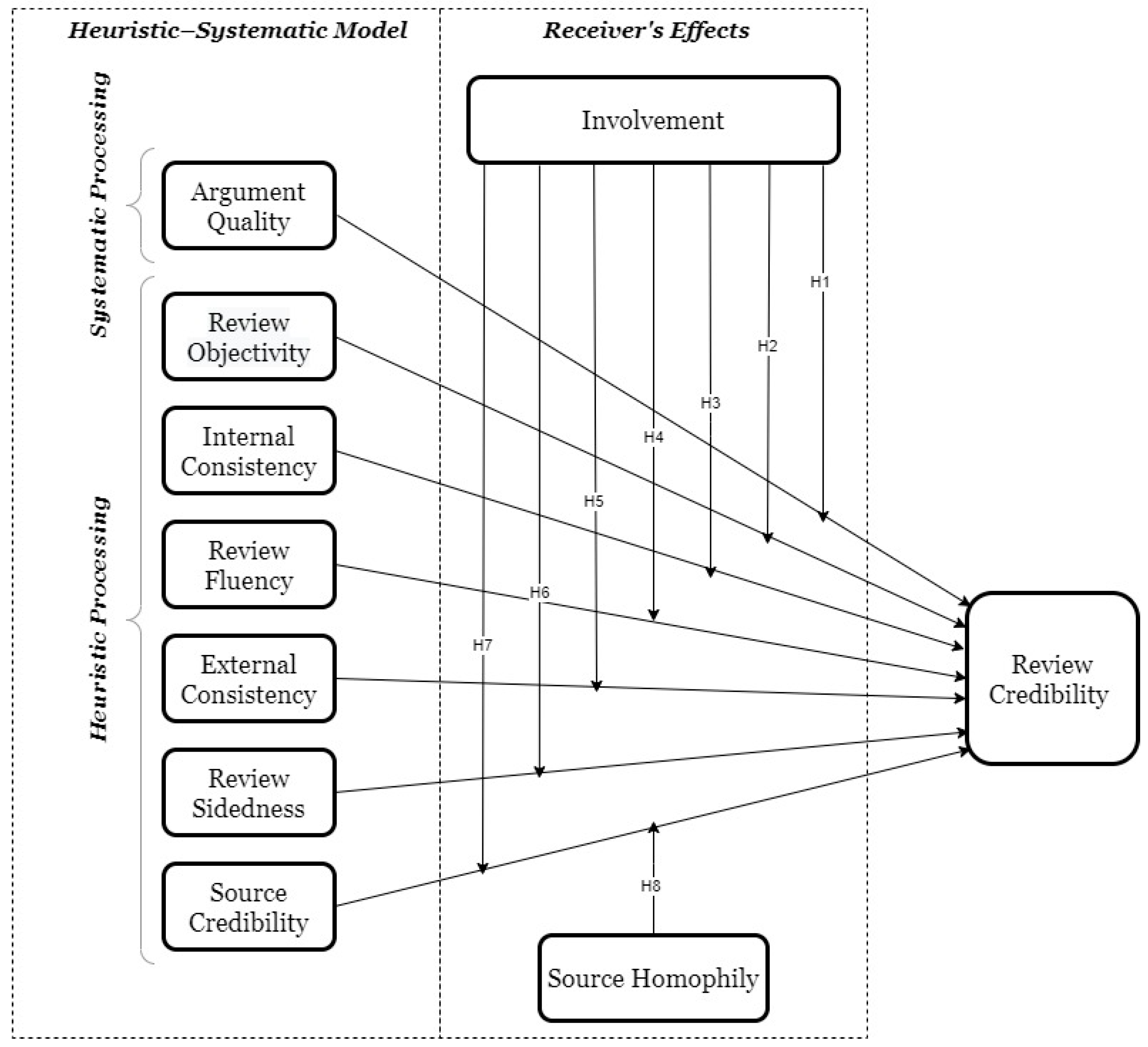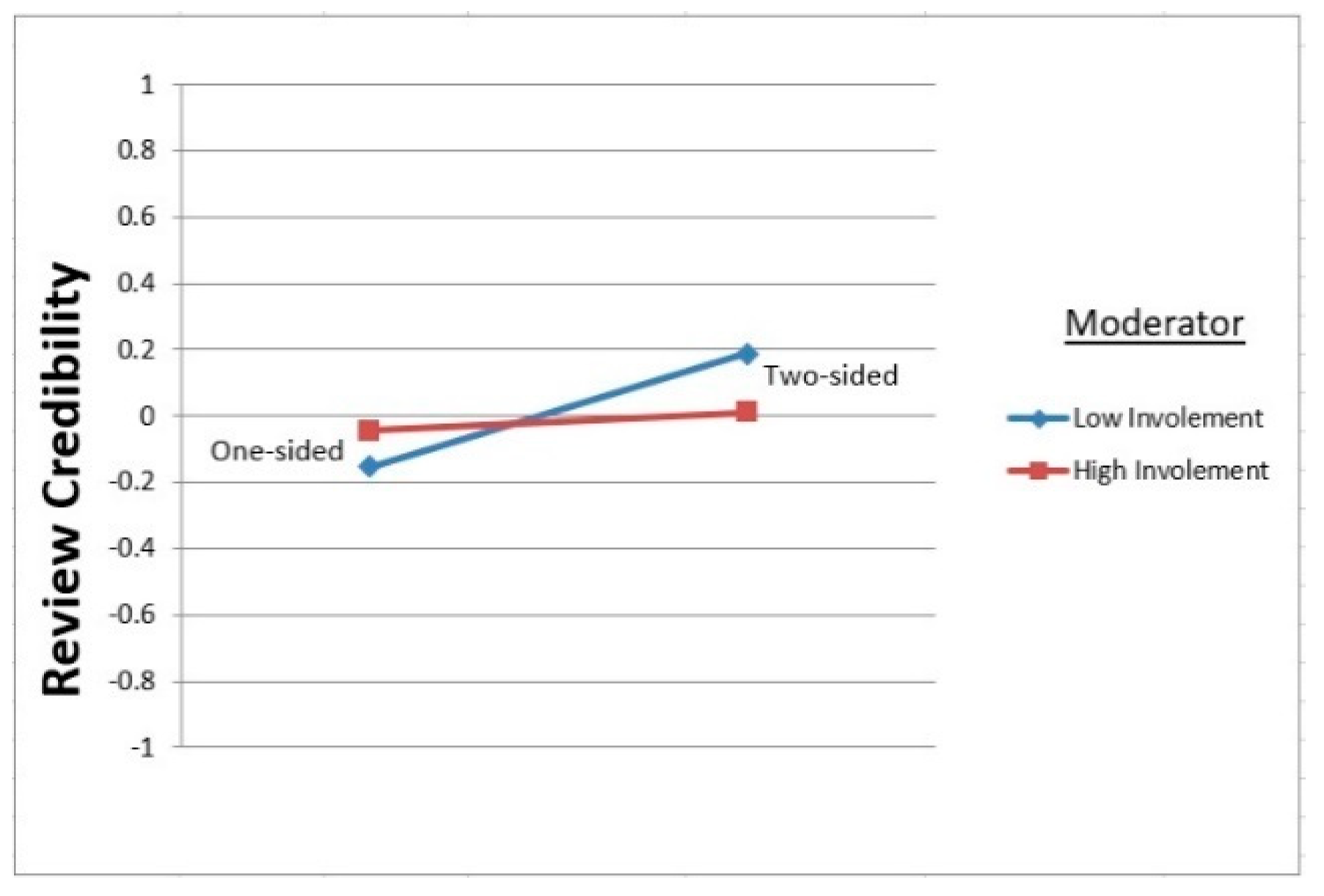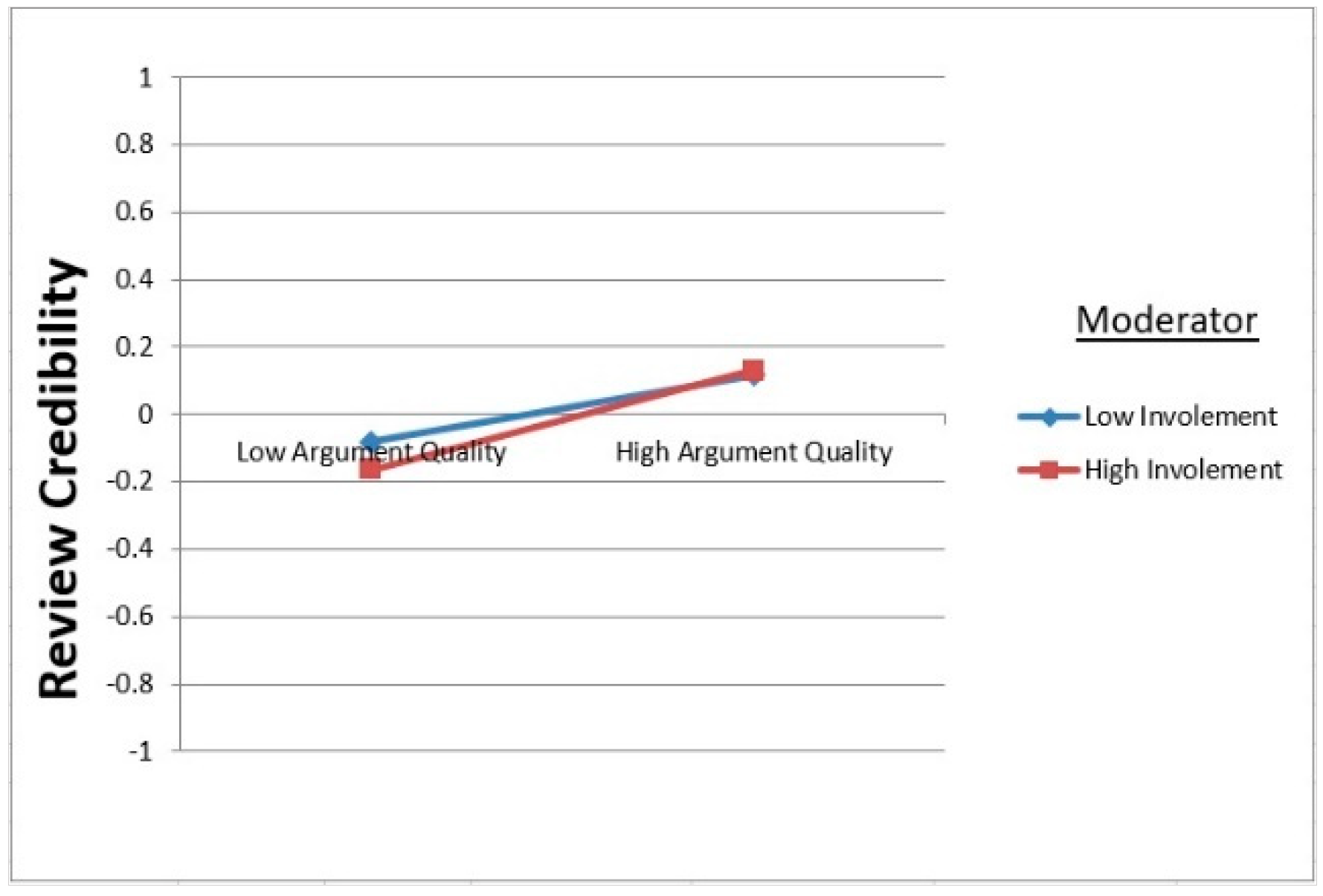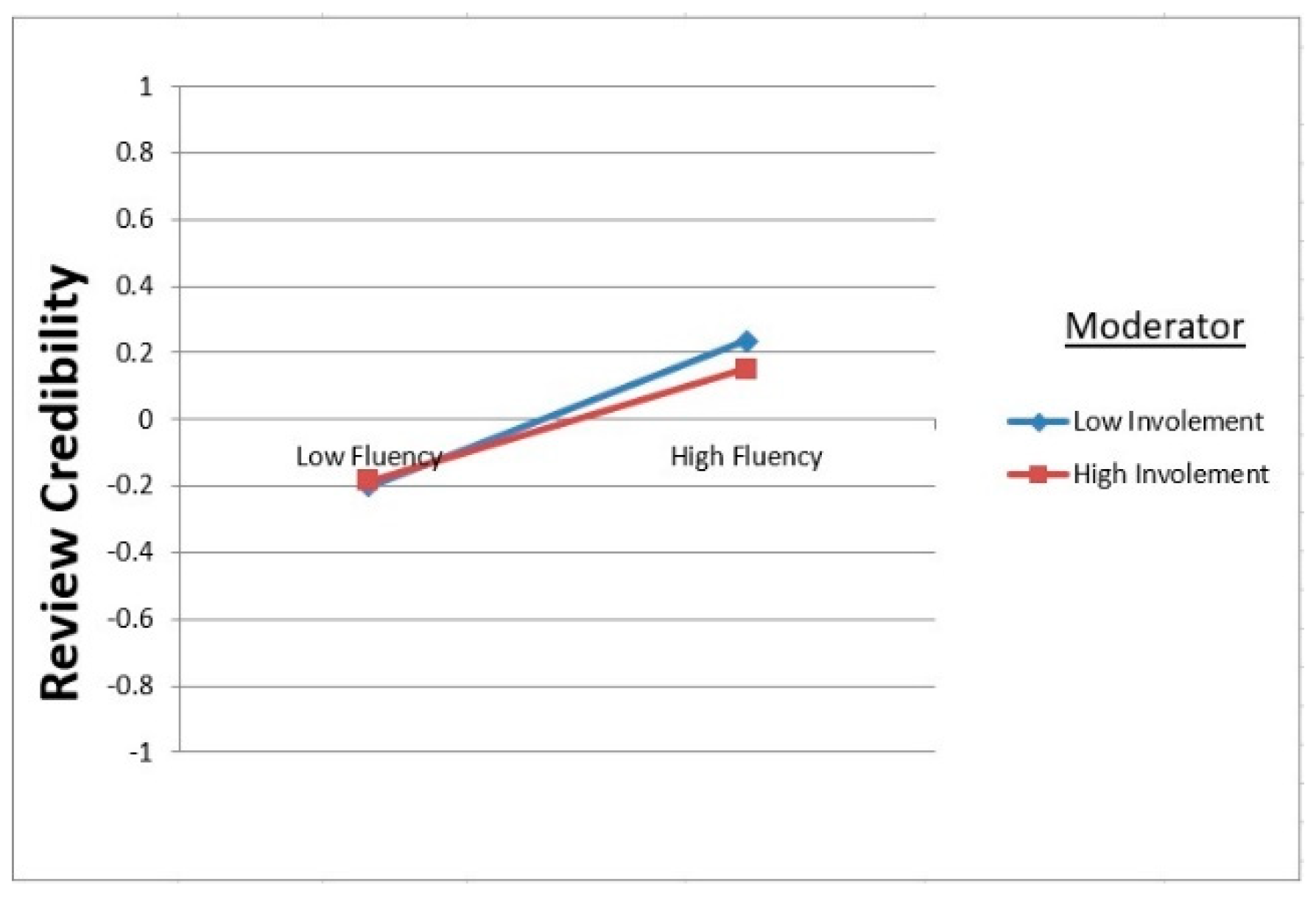1. Introduction
Web 2.0 has provided tremendous opportunities for users to share their opinions and purchasing experiences in the form of online reviews. It also enables both consumers and businesses to take advantage of mass collaboration and open-source technology (i.e., Wikinomics) to make better decisions in their daily life [
1,
2]. Currently, consumers may have access to this information almost everywhere at any time on the internet, such as e-commerce platforms, blogs, online stores, shopping forums, and so on [
3,
4,
5]. Prior studies [
6,
7,
8] indicate that prospective consumers consider online reviews to make an assessment of products, services, and target stores. For instance, Filieri, McLeay [
6] suggest that online review information has a positive effect on consumers’ purchase intention. In the same vein, Chong, Khong [
9] find that consumers are willing to adopt information from online reviews and this information has a significant impact on their planning and decisions. Zhang, Ye [
10] state that online reviews have a greater impact on the attitudes of consumers, compared to other types of information sources, such as recommendations from professional editors.
Many researchers have investigated the importance of online reviews for consumers, providers, and e-commerce platforms, e.g., [
3,
6,
11,
12,
13]. While online reviews are important, there is a potential for businesses and some consumers to write fake reviews; hence, understanding the credibility of online reviews (COR) is important to prevent consumers from being misled by non-credible reviews. As a result, the antecedent factors that impact COR have become an important and imperative research topic in information systems, computer science and business domains. Prior research explores this issue and identifies antecedent factors to predict the COR [
4,
8]. Although these scholars make substantial contributions to realizing different effects of online reviews, according to our best knowledge, there is little research that has considered the effect of the readers’ perspective on perceived credibility.
Dual-process theories [
14,
15] and informational influence literature suggest that attributes related to the (i) message (textual content), (ii) source (writer), and (iii) receiver (reader) change a message’s effect. However, most prior research has only focused on two aspects: the message and the source, ignoring the reader’s perspective. We expect that it is only by examining all three of these aspects that their effect on the COR can be studied. Beyond that, we argue that readers of online reviews use multiple attributes to different degrees to assess COR. Accordingly, one piece of online review may reflect different views for different readers depending on their attitudes, such as their involvement in the product or service and how they perceive similarity between themselves and reviewers, called ‘homophily’ [
16]. Because prior research does not systematically study these issues, little is known about how readers’ involvement and homophily change the COR assessment. In this study, we aim to fill this gap through an investigation of how readers’ involvement moderates the relationships between COR and its antecedent factors. In addition, we focus on exploring the moderating role of homophily on the relationship between source credibility and the COR. Thus, this research aims to answer the following questions:
How does the readers’ involvement moderate the effect of antecedent factors on COR?
Will similarity evaluation between the source and the reader (homophily) moderate the source credibility effect on COR, and if yes, to what extent?
This study makes significant theoretical and practical contributions. From a theoretical perspective, our study contributes to information processing literature and theories, especially in the online review context, and it also suggests a better classification of the attributes related to online reviews using the HSM theory. As prior studies e.g., [
3,
7,
11,
17,
18,
19,
20] have already proposed and incorporated moderators and antecedent factors in the online review context, this study extends this research scope by considering readers’ involvement and homophily in the extant COR theoretical model. From a practical perspective, this study will help online stores and e-commerce platforms to design better approaches to customize different online reviews and information to different people, and will also help consumers to satisfy their information needs.
The rest of the paper is structured as follows. In
Section 2, we explain the theoretical background of this study and propose our research hypotheses. We then describe the methodology of our study in
Section 3. In
Section 4, we present the results of our study. In
Section 5, we discuss our findings and present the theoretical contributions and practical implications. Finally, in
Section 6, we conclude the paper with directions for research.
3. Methodology
We created a research project design to gather our data and test the research hypotheses. The data collection process was administered through Amazon Mechanical Turk (AMT) and regression modelling was performed to analyze the data and answer research questions. In the following sections, we explain our research methodology.
3.1. Measures and Questionnaire Design
All the items for each construct used in the survey were measured through a Likert scale (from strongly disagree to strongly agree). We also embedded some control questions into the survey to check the validity of the responses and data collected.
Table 1 demonstrates the constructs and their corresponding items used in this study. As shown in
Table 1, all the items (except items for internal consistency) were adapted from the existing literature, with minor modifications to adjust the context of our study. The response items for “internal consistency” are new because we could not find a reliable scale for this attribute in the existing literature.
Appendix A provides an explanation of the scale development process for this attribute.
The survey incorporates four different sections. In the first section, we provide participants with an introduction, including a brief description of the project and its aims. In the second section, we present all the constructs, items and survey questions. In the third part, we ask demographics related questions from each participant. Lastly, in the fourth section, each participant receives a unique code and be informed of the process to get their payment.
3.2. Field Data
Before the main administration of the survey, we conducted pilot tests to ensure that there was no issue in the survey’s components. To do so, we gathered comments from all the authors of this paper and 44 online users. The main data collection was carried out through AMT. AMT allows us to recruit qualified respondents who are members of online communities and users of e-commerce platforms. As such, collecting our sample from actual online users strengthens the validity of our research.
During the data collection process, respondents were notified that they would receive ~1.5 AUD for their participation. If they agreed, we asked them to read one consumer review, and then respond to the survey’s questions.
We collected 471 samples; of these, 46 respondents were excluded from our pool because they did not pass the control questions, leaving 425 valid subjects. In
Table 2, we demonstrate the demographic information of our sample.
5. Discussion
In this study, we systematically investigated the moderating effect of reader’s involvement (RI) on the relationships between the COR and its antecedent factors. In addition, we explored the moderating role of homophily on the causal effect of source credibility on the COR. Firstly, we tested the main effect of our proposed research model. The results indicate that most of the antecedent factors, namely argument quality, review sidedness, review objectivity, internal consistency, review fluency, and source credibility significantly impact the COR. Whereas, external consistency was insignificant in this model, showing that not all the independent attributes exert an effect on the reader of a review. Next, we tested our hypotheses H1–H7. We predict RI can moderate the antecedent factors’ effects on the COR. The statistical results validate the importance of exploring the effects of readers’ perspectives during the processing of online review information.
We found that argument quality does not significantly vary across different readers (consumers) with different levels of involvement, rejecting H1. We predict this is due to the fact that consumers visit e-commerce platforms like online stores deliberately to find relevant information and make their purchase decision. Thus, they are motivated and involved enough to read and judge the arguments of a review and assess its quality. In this case, consumers reading online review information will consider reviews’ arguments to make their judgments, no matter how involved they are; as such, the effect of argument quality remains the same (constant effect) among consumers with different levels of involvement. For the three attributes of review objectivity, review sidedness, and internal consistency the results show that RI moderates their effects on the review credibility. This means that, as we predicted, the positive effects of review objectivity, internal consistency and review sidedness on the COR were attenuated with the increase in the involvement level, confirming H2, H3 and H6 respectively.
The results indicate that external consistency does not have a strong impact on the COR. This is consistent with the finding of Thomas, Wirtz [
59], but disconfirms the finding of Luo, Luo [
3], which states that the consistency among reviews significantly impacts the COR’s assessment. We believe our study could help explain the inconsistent results from prior research. Nowadays, we think that, in many e-commerce platforms, there is a vast number of online reviews for each product or service; however, some local platforms have only a few online reviews for their products or services. Thus, depending on the platform and the number of reviews, the effect of external consistency might vary. For instance, in a local online store, where there is a handful of reviews for a product, it is relatively easier for a customer to read all the reviews and judge the consistency among those reviews and accordingly external consistency can play a key role to assess the COR. However, when there is a large number of reviews for a product, customers might not be able to read all of them and realize the convergence among different viewpoints, as such, external consistency might not be a strong attribute for them to judge the COR [
2]. The results also indicate that RI has no moderating effect on review fluency and external consistency among reviews. This means review fluency and external consistency serve as constant attributes to impact the COR, regardless of consumers’ involvement levels. This does not confirm H4 and H5.
The findings suggest that, on e-commerce sites, consumers consider the credibility of a source as an important attribute to evaluate the COR. In addition, we found that the positive effect of source credibility on COR is strengthened with the increase in consumers’ involvement level. This finding reversely supports hypothesis 7, which suggests the effect of source credibility on COR will be stronger if consumers have a lower level of involvement. One of the explanations for this is that online reviews are mostly about consumers’ experiences and opinions toward a product/service, rather than knowledge or facts. In addition, as suggested by Shan (2016) the persuasiveness of an online review has often been attributed to its source credibility (Shan 2016). In addition, in the context of online reviews, it is challenging to understand the motives behind the reviewers and, to do so, readers should use a considerable amount of cognitive effort. Thus, readers with a low level of involvement are less motivated to scrutinize the profile of a reviewer to assess the COR. However, readers with a higher level of involvement are more inclined to carefully evaluate the profile of a reviewer to adopt information and make their purchase decision. This is another interesting finding of this study, which is consistent with the findings of prior research that suggests an information cue may perform as a heuristic (peripheral) factor in some circumstances, but a systematic factor in other circumstances [
19,
60].
Our findings show that homophily negatively moderates the causal relationship between source credibility and the COR, which reversely confirms H8 and indicates that the stronger effect of source credibility on the COR would be attenuated if the reader felt high homophily with the writer. To further clarify this effect, we conducted an extensive literature review. Perhaps the closest study to this finding is Shan [
61], which conducted two experiments to investigate the effect of system-generated and self-generated cues on source credibility judgment. According to the finding of this research, the perceived similarity between the writer and reader (homophily) generates a negative influence on source expertise. This means that, although the credibility of a source has a high positive impact on the COR, this relationship is stronger when the similarity between the reader and writer is low and, as such, a higher level of similarity brings down the strong effect of source credibility. This is an interesting finding because it shows that being similar to a consumer could potentially discount the expertise and accordingly reduce the credibility of a reviewer, because consumers tend to judge the reviewer in close proximity to themselves.
Finally, the findings illustrate that, in the context of online reviews, the impacts of reviews’ attributes seem to be highly complex. For instance, it is not advisable that we simply classify the argument quality as the only systematic processing factor and other attributes including source credibility and external consistency as the heuristic attributes, as suggested by prior research, e.g., [
19]. This is because, according to our findings, the credibility of a source plays a key role to assess COR; moreover, it has a higher impact on the highly involved readers compared to readers with a low level of involvement; therefore, it can be considered as the systematic attribute rather than the heuristic one. In addition, as supported by the HSM theory [
15,
31], it is possible that an attribute such as source credibility serves as a heuristic processing factor in some situations, but a systematic processing factor in other situations. Thus, it is highly recommended that future research focuses on the classification of the attributes used in this study in different conditions.
Theoretical Contributions and Practical Implications
This research can provide important theoretical contributions to the online reviews area. We extend the credibility of online reviews research scope by incorporating the moderating role of the reader’s attributes (reader’s involvement and homophily) into the HSM model. Our research is consistent with prior related studies [
3,
17,
19], which suggest that the readers’ perspective, e.g., level of expertise and sense of membership, serves as the moderating attributes, rather than independent antecedent ones, in the credibility evaluation of online reviews.
In fact, the findings show that readers’ involvement has different moderating effects on the antecedent factors of COR, indicating that different online readers use different attributes to assess the COR. Accordingly, the influences of various online reviews’ attributes were differentiated. Specifically, we found that the reader’s involvement positively influences the direct effect of source credibility on COR, whereas it attenuates the effects of internal consistency, review sidedness, and review objectivity on the COR. In addition, it does not significantly moderate the effects of argument quality, review fluency, and external consistency on COR.
This research also provides several practical implications to online stores and other e-commerce platforms. A potential consumer might have different characteristics; as such, e-commerce platforms should customize their online reviews for each consumer accordingly in order to attract and motivate them to purchase. One practical way to customize online reviews for different consumers is to capture their log-in information or create a profile for each consumer. By doing this, the platform can classify consumers into different categories based on their profiles. After finishing the classification, the platform will be able to recommend customized information to each consumer. By doing so, the platform will not only help consumers to make better purchase decisions, but also help businesses to achieve their goals and increase their performance.
6. Conclusions and Future Research
Using HSM as the theoretical lens, this paper explores how readers’ attributes (i.e., involvement and homophily) moderate the relationships between the credibility of online consumer reviews and its antecedent factors. Our findings show that one piece of online review may reflect different views for different readers depending on their attitudes. This study provides a better classification of the attributes related to the credibility of online reviews using the HSM theory and helps e-commerce platforms to customize their online reviews to different consumers and satisfies their information needs.
We suggest future research could compare different types of products and/or services (e.g., search, experience and credence categories) because we believe that consumers judge online reviews for each category differently. This means that, during the assessment of online reviews, consumers use different attributes to different degrees, depending on the product/service types, to make their decisions. Thus, product or service types can affect consumers’ assessment of online reviews. Finally, the importance of demographic variables on the credibility evaluation of online reviews can be explored in further studies, considering that digital platforms increasingly have more information about their users.














